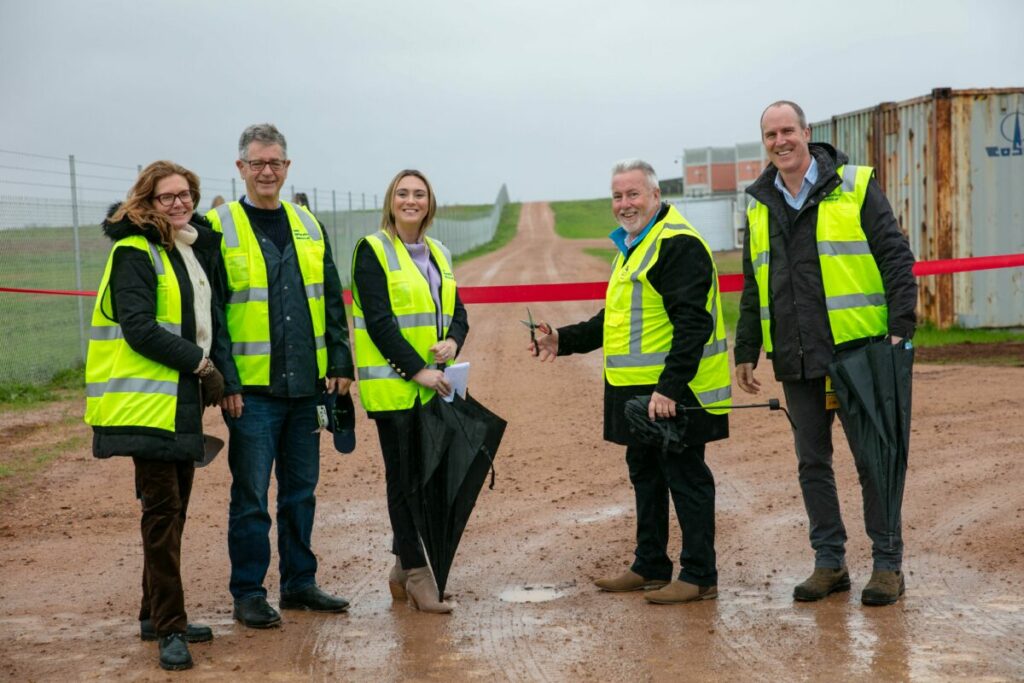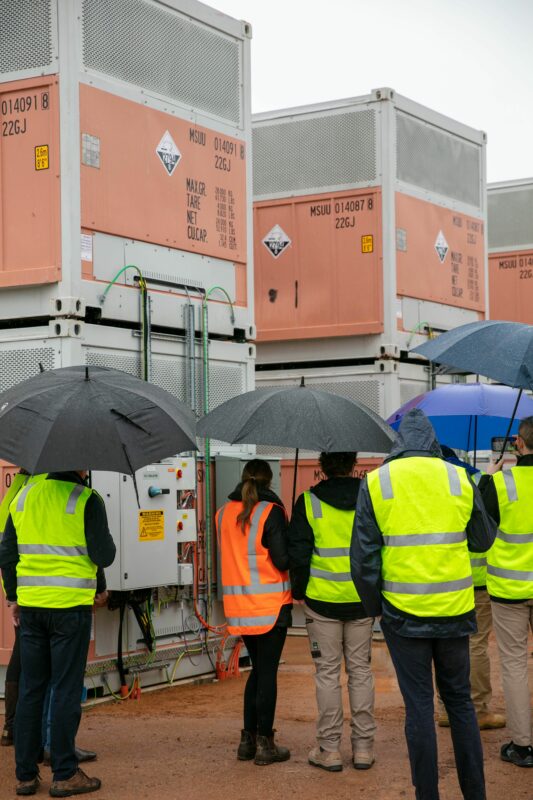
The state premier of Queensland, Australia, has visited the opening of a vanadium electrolyte factory, and the company building it has just ordered a vanadium flow battery from Sumitomo Electric.
Meanwhile, the country’s first grid-scale vanadium flow battery project, in South Australia, is taking shape, as seen in an open day event held on Wednesday (21 June).
Enjoy 12 months of exclusive analysis
- Regular insight and analysis of the industry’s biggest developments
- In-depth interviews with the industry’s leading figures
- Annual digital subscription to the PV Tech Power journal
- Discounts on Solar Media’s portfolio of events, in-person and virtual
Queensland Premier Annastacia Palaszczuk was on hand yesterday as Vecco Group, a locally headquartered company developing both primary vanadium extraction operations as well as electrolyte manufacturing facilities, heralded the opening of its AU$26 million (US$17.42 million) factory.
The Townsville Vanadium Battery Manufacturing Facility will produce liquid electrolyte made with vanadium pentoxide (V2O5), for use in vanadium redox flow battery (VRFB) energy storage devices. According to prior announcements, it will have an initial 175MWh annual production capacity, capable of ramping up to 350MWh.
Progress on the site has been rapid, with the start of construction only officially announced in March, again at an event attended by Palaszczuk.
The politician’s attendance at both events signifies the importance Queensland’s government has placed on the potential of clean energy technologies – and vanadium flow batteries in particular – to both assist in the state’s own decarbonisation and in creating economic growth and industrial opportunities there.
While at the event, the premier also announced that AU$1 billion in coal industry royalties will be leveraged to enable a massive upgrade to the state’s transmission network, called Copperstring 2032. Just over half of that amount (AU$594 million) will be committed to the project this year.
The Queensland government said a while ago that it had heard from noted battery industry expert Robert Galyen, who among other things was a contributor to battery maker CATL’s phenomenal rise, that access to energy for production and transportation is a key source of constraints and bottlenecks to those clean energy manufacturing ambitions. Copperstring is aimed at helping unlock that access.
In fact, the Vecco plant forms part of a wider green energy manufacturing hub for critical minerals being sited in Townsville, and Palaszczuk’s government committed to supporting it financially back in January. At that time, it was noted that Queensland is thought to hold as much as 30% of the world’s primary vanadium reserves.
While a report prepared on behalf of the government by consultancy Accenture found Queensland had the potential to capitalise on opportunities in various clean energy technologies, with an estimated AU$500 billion worth of raw materials in total in the region, it was in vanadium flow batteries that the state could hold a competitive advantage over many other regions, the consultancy said.
On initial opening, the Vecco plant is expected to be fed by vanadium sourced from industrial waste from a local provider, but in time Vecco plans to use its own mine in Queensland’s Julia Creek for feedstock.
VRFBs are essentially batteries that, unlike lithium-ion, do not contain power stack and electrolyte within the same cell. Instead the electrolyte is contained in tanks. This offers a number of perceived advantages, such as a longer lifetime of heavy cycling without degradation, lower fire risk and ability to scale up energy capacity to handle long-duration energy storage (LDES) applications.
To date, however, their upfront cost has been higher than lithium-ion battery energy storage system (BESS) technologies, meaning uptake has been limited, even though the VRFB’s technical profile means a lower cost of ownership over lifetime, manufacturers claim.
Perhaps more immediate a concern is that if and when demand for the VRFB technology takes off, access to electrolyte will likely dictate how many of the systems can be deployed and where, as Samantha McGahan of another vertically integrated vanadium startup, Australian Vanadium, wrote in a recent Guest Blog for this site.
“I want to see vanadium mined in Queensland, processed in Queensland, and made into vanadium batteries here in Queensland. This is just the beginning of the manufacturing and mining jobs boom that our investment in CopperString 2032 delivers for North Queensland,” Palaszczuk said.
“Queensland has unique deposits of many of the minerals needed for the global energy transformation, along with the best mining and manufacturing workforce.”
Queensland trial deployment, grid-scale project in South Australia
Also announced yesterday was a VRFB trial project for Queensland government-owned energy company Energy Queensland’s power distribution subsidiary Energex.
Vecco Group has ordered a 250kW/750kW (3-hour duration) VRFB system from Japanese manufacturer Sumitomo Electric. Sumitomo Electric has been manufacturing flow batteries for several years, and is behind two of the world’s largest projects of their type, a 60MWh system inaugurated back in 2015 and a 51MWh system brought online in 2022, both in the northern Japanese island prefecture of Hokkaido.
Sumitomo Electric also delivered the US’ biggest VRFB project to date, a 2MW/8MWh trial deployment for a microgrid in California with utility San Diego Gas & Electric (SDG&E).
The medium-duration energy storage trial project will assess how the technology could be used on Energex’s electricity distribution network. It will be installed in the suburb of Berrinba, in Queensland’s Logan City.
Its main application will be to help integrate generation from Queensland’s growing shares of rooftop solar PV systems into the network, particularly for use in evenings and at night. The state is targeting an 80% share of renewable energy in its power sector by 2035.
Installation of the system is expected to begin in December this year.

Already under construction and entering its commissioning phase is a 2MW/8MWh VRFB system from Anglo-American flow battery company Invinity Energy Systems in Port Pirie, in rural South Australia.
DC-coupled to a 6MWp solar PV array it is another site set to deliver medium-duration energy storage. Called Spencer Energy Project, the plant has been supported with funding from the national government’s Australian Renewable Energy Agency (ARENA), with AU$5.7 million pledged towards its total cost of just over AU$20 million back in late 2020 when the project was announced.
An Open Day was held this week to celebrate completion of civil works and the start of commissioning of a system that Yadlamalka Energy said will enable the dispatch of around 10GWh of stored energy into the grid each year.
The VRFB will be charged with surplus solar-generated energy, although the developer said it could also in future be used to charge directly from the grid at off-peak times when energy is cheaper and more plentiful.
Spencer Energy Project is thought to be Australia’s first grid-scale VRFB project, and its largest, which gives an interesting symmetry to the fact that the technology’s invention owes a lot to academics at the University of New South Wales (UNSW) who in the early 1980s perfected the basic design and electrolyte chemistry still used today.
Energy-Storage.news’ publisher Solar Media will host the 1st Energy Storage Summit Asia, 11-12 July 2023 in Singapore. The event will help give clarity on this nascent, yet quickly growing market, bringing together a community of credible independent generators, policymakers, banks, funds, off-takers and technology providers. For more information, go to the website.

